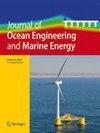Benchmarking study of 10 MW TLB floating offshore wind turbine
IF 2.8
Q4 ENERGY & FUELS
引用次数: 0
Abstract
Abstract This paper presents a benchmarking study of four floating wind platform’ motion and dynamic tension responses to verify an innovative design with the intention of overall cost reduction of a durable, reliable, safe design. An aero-hydro-servo-elastic code is applied to benchmark a 10 MW tension leg buoy (TLB) floating wind turbine to the current leading technology types for floating offshore wind platforms, specifically spar buoy, Semi-submersible and tension leg platform (TLP) floating wind turbines. This study assumes that the platforms will deploy in the northern region of the North Sea, with a water depth of 110 m under various environmental conditions, including wind field descriptions covering uniform wind to fluctuating turbulent wind. The obtained dynamic response results showed low motion responses for the TLB platform for all design load cases. More specifically, the TLB surge and pitch motion responses are insignificant under both operational and survival conditions, allowing decreased spacing between individual wind turbines and increasing wind farms' total energy generation capacity. An additional benefit is that the wind turbine systems can be installed without significant pitch modification to the control system. The TLB platform is less complex which simplifies the construction process and has the potential for significant cost reductions.10mw TLB浮式海上风电机组标杆试验研究
摘要:本文对四个浮式风力平台的运动和动态张力响应进行了基准研究,以验证一种创新设计,其目的是降低总体成本,实现持久、可靠、安全的设计。应用航空-液压-伺服-弹性代码对10 MW张力腿浮标(TLB)浮式风力涡轮机进行了基准测试,以衡量目前海上浮式风力平台的领先技术类型,特别是桅杆浮标、半潜式和张力腿平台(TLP)浮式风力涡轮机。本研究假设平台将部署在北海北部地区,水深为110 m,在各种环境条件下,包括从均匀风到波动湍流风的风场描述。得到的动态响应结果表明,在所有设计荷载情况下,TLB平台的运动响应都很低。更具体地说,在运行和生存条件下,TLB浪涌和俯仰运动响应都是微不足道的,这可以减少单个风力涡轮机之间的间距,增加风力发电场的总发电量。另一个好处是,风力涡轮机系统可以安装,而不需要对控制系统进行重大的螺距修改。TLB平台不太复杂,简化了施工过程,具有显著降低成本的潜力。
本文章由计算机程序翻译,如有差异,请以英文原文为准。
求助全文
约1分钟内获得全文
求助全文
来源期刊

Journal of Ocean Engineering and Marine Energy
Engineering-Ocean Engineering
CiteScore
3.80
自引率
5.30%
发文量
47
期刊介绍:
The Journal of Ocean Engineering and Marine Energy publishes original articles on research and development spanning all areas of ocean engineering and marine energy. The journal is designed to advance scientific knowledge and to foster innovative engineering solutions in the following main fields: coastal engineering, offshore engineering, marine renewable energy, and climate change and the resulting sea-level rise. Topics include, but are not limited to: Offshore wind energy technologyWave and tidal energyOcean thermal energy conversionOceanographical engineeringStructural mechanicsHydrodynamicsLinear and nonlinear wave mechanicsNumerical analysisMarine miningPipelines and risersComputational fluid dynamicsVortex-induced vibrationsArctic engineeringFluid-structure interactionUnderwater technologyFoundation engineeringAquacultural engineeringInstrumentation, full-scale measurements and ocean observational systemsModel testsHydroelasticityOcean acousticsGlobal warming and sea level riseOcean space utilizationWater qualityCoastal engineeringPhysical oceanographyThe journal also welcomes occasional review articles by leading authorities as well as original works on other emerging and interdisciplinary areas encompassing engineering in the ocean environment.
 求助内容:
求助内容: 应助结果提醒方式:
应助结果提醒方式:


